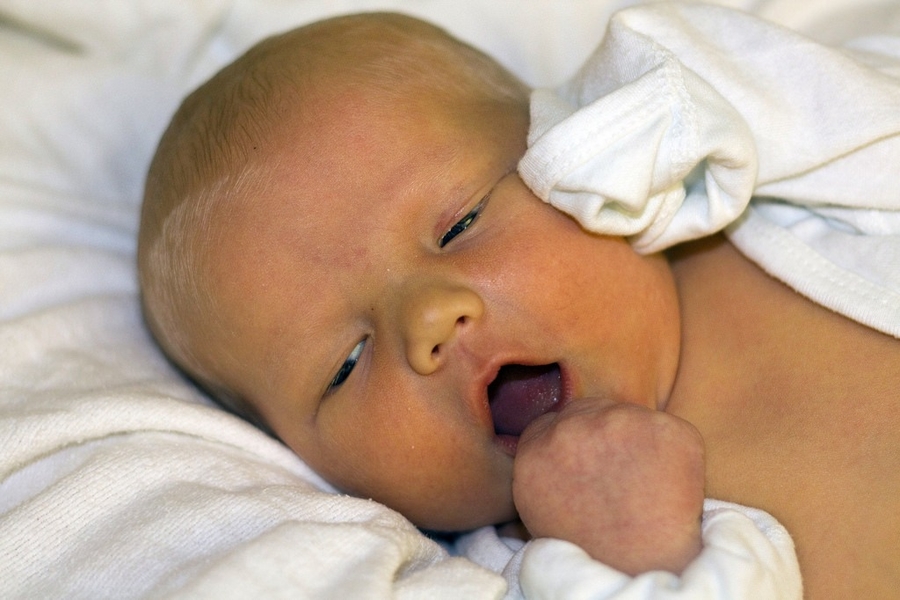
Jaundice In Babies – What Are The Causes, Symptoms & Treatment
21 Mar 2018 | 4 min Read
Babychakra
Author | 1369 Articles
What is jaundice in newborns?
Neonatal jaundice i.e. jaundice in babies is medically termed as hyperbilirubinaemia. It occurs due to increased level of a substance called bilirubin in the blood of the baby. It leads to presence of a yellowish tint of the skin or the white portion in the eyes (sclera).Bilirubin is normally present in a baby as well as in adults, but when levels cross the healthy levels is when it causes skin tinting and other complications.
Neonatal jaundice is commonly seen in the first week of life. Many babies have usually left for home by the time the symptoms of jaundice can be seen. Hence, a paediatrician performs a follow-up examination at 3 to 5 days of birth.
Most babies usually show mild symptoms of jaundice which is not a sign of illness. This usually resolves within one or two weeks without any complications. However, in some cases, if the bilirubin levels remain high for a long time and are left untreated, they can lead to a condition called kernicterus which can cause brain damage and other lifelong problems. Hence, in all instances, jaundice should be taken seriously and evaluated for presence of underlying cause for such high levels.
What are the causes of jaundice in newborns?
Jaundice occurs when the body produces more bilirubin than it can metabolise and excrete from the body. Bilirubin is a yellow-coloured substance, produced when old red blood cells are broken down in the body when they become too old or useless. Bilirubin is normally removed from the body through urine and stools to maintain optimal levels. During pregnancy, the bilirubin is removed from the baby’s body through the placenta.
In most cases of jaundice in newborns, babies suffer from what is known as physiological jaundice. This happens due to excess breakdown of fetal red blood cells, and due to the inability of the baby’s liver to remove the extra bilirubin completely. Such jaundice is seen within 24 hours after birth. It increases by the third or the fourth day, and resolves within a weeks’ time by itself.
In other cases, pathological jaundice may be seen in the neonatal period due to infections, enzyme deficiency, or incompatibility between the baby’s and the mother’s blood groups.
What are the symptoms of neonatal jaundice?
If a baby is suspected of having neonatal jaundice, the skin and the white portion in the eyes appear yellow. The yellow discoloration is initially seen in the face and chest, 1 to 5 days after birth.
A baby with increased bilirubin levels will show:
- Yellow discoloration of skin and sclera in eyes
- Sluggishness
- Refusal to feed
- Crankiness
- Arching of back
- High pitched crying
- Weight loss
How is neonatal jaundice diagnosed?
The doctor will perform a physical examination and enquire about the health of the mother and the baby. He may enquire about their blood groups. A blood test to check for bilirubin is done to determine the levels of bilirubin and to assess if the baby needs further treatment. Additional tests may be needed for diagnosis of underlying cause of increased bilirubin.
How is jaundice in infants treated?
Mild jaundice resolves spontaneously within two to three weeks, and no treatment is needed. For moderate to severe cases, the baby might be admitted to a healthcare facility. The baby is kept under a type of fluorescent lighting to treat jaundice. This is known as phototherapy. The skin absorbs the fluorescent light that acts on the bilirubin molecules, allowing them to be excreted rapidly in the urine and stools. Avoid treating the baby under sunlight. Special lights and controlled settings are needed to treat jaundice.
If there are other conditions that have caused the jaundice, they may need other forms of treatment. For instance, if the jaundice is caused due to Rh incompatibility the baby may need a blood transfusion.
Neonatal jaundice is commonly part of the growth process of a baby. However, increased bilirubin levels that do no subside in the first week of life can indicate a disease and prove dangerous. Hence, it is best to consult a doctor right away and treat it.
Also read: All you need to know about Jaundice in Newborn Babies – Part 1
A


Related Topics for you
Suggestions offered by doctors on BabyChakra are of advisory nature i.e., for educational and informational purposes only. Content posted on, created for, or compiled by BabyChakra is not intended or designed to replace your doctor's independent judgment about any symptom, condition, or the appropriateness or risks of a procedure or treatment for a given person.
